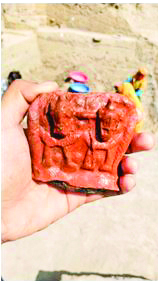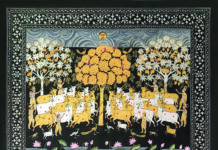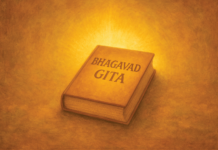ASI’s Deeg excavation reveals ancient riverbeds, iron usage, early Brahmi script, and Vedic religious artifacts, reshaping Indian history.
Mother-earth has preserved several layers of secret in its bosom. Government supported initiatives in past few years have started exploring our ancient roots, which have remained out of plain sight for centuries. In this direction, the Archaeological Survey of India (ASI) has made groundbreaking discoveries in Bahaj village, Deeg district, Rajasthan, fundamentally reshaping our understanding of ancient Indian civilization.
This excavation, conducted from January 2024, for almost one and a half years, represents one of the most significant archaeological undertakings in Rajasthan since the Kalibangan excavations. Located approximately 50 kilometers from Mathura in the sacred Braj region, Bahaj village sits at the base of the revered Govardhan Hill, the ASI team, headed by Superintending Archeologist Dr. Vinay Kumar Gupta conducted the deepest excavation in Rajasthan’s archaeological history, reaching 23 meters below the surface— a depth that has yielded unprecedented insights into India’s ancient past. This strategic location in the Braj region, traditionally associated with Lord Krishna’s divine activities, has proven to be a treasure trove of archaeological evidence spanning multiple millennia.
Revolutionary Discovery of the Paleochannel
The most remarkable discovery is an ancient, dried riverbed found at the excavation’s lowest stratum, approximately 23 meters deep. This paleochannel represents the first such finding in Indian archaeological history and has captured the attention of historians and archaeologists worldwide. ASI describes this discovery as “unprecedented” and notes its potential connection to the mythical Saraswati River mentioned in the Rigveda. The discovery challenges existing theories about settlement patterns in the region.
Previously, archaeological mounds in areas like Mathura, Mainpuri, and Mewat were attributed simply to continuous human habitation over generations. However, this finding suggests that ancient communities deliberately settled atop dried riverbeds, establishing new civilizations on these elevated positions. Located approximately 150 kilometers east of known Harappan civilization sites where Saraswati traces have been identified, and at the beginning of the Ganga-Yamuna Doab, this paleochannel may represent a crucial link in understanding ancient river systems. Scientific dating will ultimately determine whether this represents the dried Yamuna, Saraswati, or another ancient waterway.
Ochre Colored Pottery and the Mahabharata Connection
One of the most significant discoveries is the extensive presence of Ochre Colored Pottery (OCP) found at depths exceeding 20 meters. This pottery culture, traditionally dated to 2000- 1500 BCE, has been recovered from layers that may be even older, potentially dating to 3000 BCE or earlier. The OCP discovery is particularly significant because recent archaeological theory suggests that OCP culture, rather than the previously assumed Painted Grey Ware (PGW) culture, represents the true archaeological signature of the Mahabharata period. This paradigm shift could push the dating of the Mahabharata from the traditionally accepted 1000-800 BCE to as early as 3000 BCE. This finding may necessitate a fundamental revision of NCERT textbooks, which currently date the Mahabharata period to around 1000 BCE.
Religious and Spiritual Artifacts
The excavation has yielded remarkable religious artifacts that illuminate ancient Indian spiritual practices. Among the most significant discoveries are anthropomorphic figurines of Lord Shiva and Mata Parvati, estimated to be approximately 3,500 years old. These terracotta representations feature the divine couple with three votive discs and challenge previous assumptions about the timeline of anthropomorphic deity worship in India.
Until this discovery, scholars believed that ancient Shiva worship was primarily limited to symbolic representations through the Shivling. The Deeg findings suggest that figurative worship of divine couples in male-female form was practiced much earlier than previously assumed. Additionally, a statue resembling Virupaksha (a form of Lord Shiva) with distinctive moustaches, dated to approximately 2,300 years ago, pushes back the timeline for this particular form of Shiva worship.
Perhaps most intriguingly, the excavation has uncovered statues of the Ashwini Kumaras, the divine twin horsemen mentioned among the 33 Vedic deities. These approximately 2,000-yearold sculptures represent the first evidence of these twin gods found in India before 700 BCE, with this evidence dating to around 200 BCE. The Ashwini Kumaras, known in the Mahabharata as Dstra and Nastya, are associated with medicine, health, dawn, and the sciences.
Ritual Architecture and Metallurgical Evidence
The site has revealed an extraordinary concentration of fifteen yajna kunds (sacrificial fire altars), providing concrete evidence of Vedic and post-Vedic religious practices. These ritual installations, some dating back 2,500 years, were discovered filled with sandy soil and miniature pots containing uninscribed copper coins.
The Deeg excavation has uncovered compelling evidence of sophisticated metallurgical knowledge among ancient inhabitants. Iron objects found alongside OCP pottery could potentially date to 3000 BCE, which would represent a revolutionary discovery in the global understanding of iron usage. If confirmed through scientific testing, this would challenge the current global narrative that credits Mesopotamia with the earliest iron usage around the same period.
Beyond raw iron artifacts, the site has revealed evidence of advanced metallurgical facilities, including an ancient iron smelting facility. The discovery of furnaces and metallurgical workshops indicate that the inhabitants possessed sophisticated knowledge of metal processing techniques. Additionally, a gemstone workshop has been identified, along with tools crafted from animal bones, including needles and pens.
Trade Networks and Early Writing Systems
The excavation has revealed evidence of extensive trade networks and craft specialization. Discoveries include conch shell bangles and semi-precious stone beads, which reflect both trade connections and sophisticated jewelry-making traditions. The presence of jewelry predating even the pre-Harappan civilization indicates that India had highly developed ornamental traditions thousands of years ago. Among the most academically significant discoveries are four unbaked sealings, two inscribed with Brahmi letters. These represent potentially the earliest datable evidence of the Brahmi script on the Indian subcontinent. The Brahmi script, which forms the foundation of most modern Indian writing systems, has traditionally been dated to the 3rd century BCE based on Ashoka’s edicts. The Deeg discovery could push back the origins of Indian writing systems significantly earlier than currently accepted timelines.
Scientific Analysis and Cultural Implications
The ASI has implemented rigorous scientific methodologies to ensure accurate dating and analysis of discovered artifacts. A human skeleton found during excavation has been sent abroad for comprehensive examination, demonstrating the international collaboration. The team has recovered over 800 artifacts in total, including pottery, seals, copper coins, sculptures, and various tools. The discoveries challenge the Aryan Invasion Theory by providing evidence of indigenous technological and cultural development.
The potential early dating of iron usage, sophisticated craft traditions, and advanced religious practices all point to an indigenous development of civilization rather than external cultural importation. The Deeg excavation holds special significance for understanding the cultural continuity of the Braj region. Local traditions maintain that Bahaj village was founded by Vajranabh, the greatgrandson of Lord Krishna, and the excavation’s findings provide archaeological context for these traditional narratives. The discovery of multiple periods of settlement demonstrates that this region has been continuously sacred and culturally significant for over four millennia. The Braj region holds secrets of not only Vedic culture but also of Buddhist and Jain traditions.
A comprehensive study would reveal the holistic evolution of cultural patterns through different layers of time. Scientific dating of key artifacts is crucial for confirming the revolutionary implications of these finds. The site is likely to be declared a National Archaeological Protected Area, ensuring its preservation for future generations of researchers. The Deeg excavation stands as a testament to India’s rich archaeological heritage and the potential for future discoveries to continue expanding our knowledge of human civilization’s earliest chapters.
Neeru Misra is visiting professor at BL Institute of Indology in Delhi.








